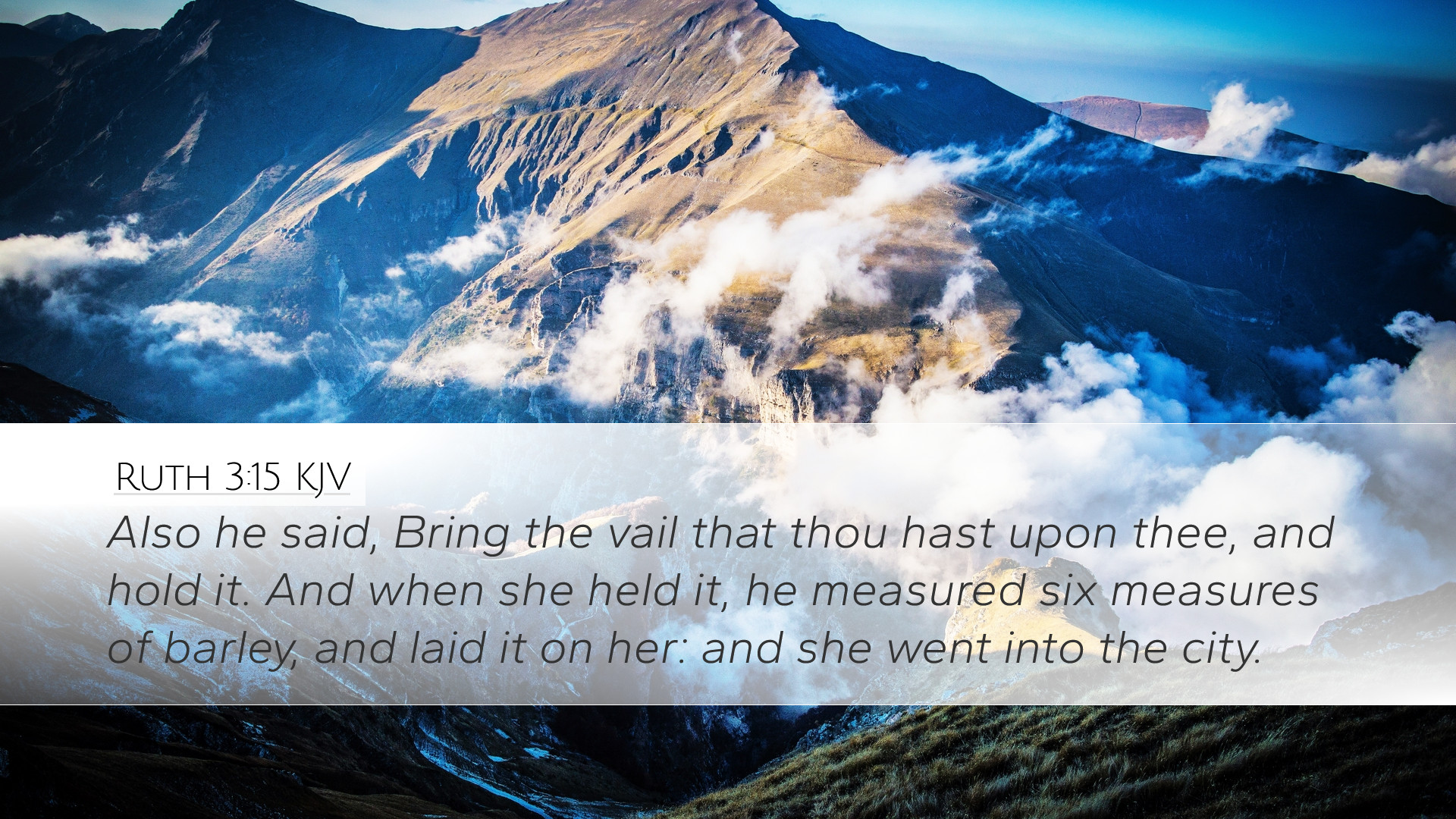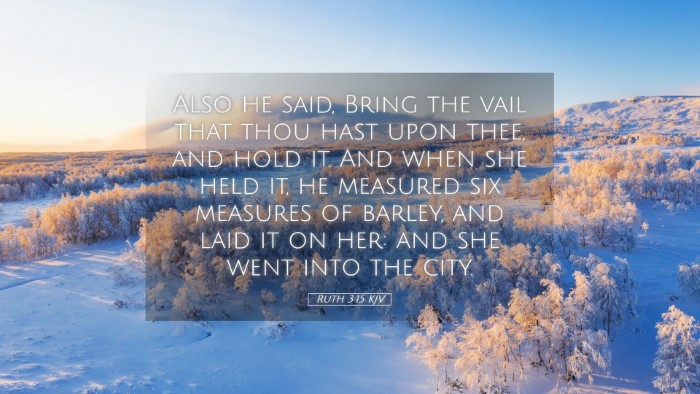Old Testament
Genesis Exodus Leviticus Numbers Deuteronomy Joshua Judges Ruth 1 Samuel 2 Samuel 1 Kings 2 Kings 1 Chronicles 2 Chronicles Ezra Nehemiah Esther Job Psalms Proverbs Ecclesiastes Song of Solomon Isaiah Jeremiah Lamentations Ezekiel Daniel Hosea Joel Amos Obadiah Jonah Micah Nahum Habakkuk Zephaniah Haggai Zechariah MalachiRuth 3:15
Ruth 3:15 KJV
Also he said, Bring the vail that thou hast upon thee, and hold it. And when she held it, he measured six measures of barley, and laid it on her: and she went into the city.
Ruth 3:15 Bible Commentary
Commentary on Ruth 3:15
Verse Text: "And he said, Bring the veil that thou hast upon thee, and hold it. And when she held it, he measured six measures of barley, and laid it on her: and she went into the city."
Introduction
The verse found in Ruth 3:15 serves as a pivotal moment in the narrative of Ruth and Boaz. This moment is rich with symbolism and significance that reflects deeper themes of redemption, provision, and the fulfillment of God's promises. As we explore the commentary derived from notable public domain sources, we will highlight various insights that elucidate the meaning and application of this verse for pastors, students, theologians, and Bible scholars.
Contextual Analysis
Before delving into verse 15, it's vital to understand the context surrounding it. The Book of Ruth unfolds during the time of the judges in Israel, a period marked by social turmoil and spiritual decline. Boaz, belonging to the family of Naomi's deceased husband, acts as a kinsman-redeemer, reflecting the law of levirate marriage (Deuteronomy 25:5-10) and aspects of God's providential care for His people.
Setting the Scene
In the previous verses, Ruth approaches Boaz at the threshing floor following Naomi's counsel. Her act of uncovering Boaz’s feet signifies an appeal for protection and a request for marriage. Boaz’s response to her initiative is not only gracious but also filled with honor and respect towards Ruth's character.
Commentary Insights
Matthew Henry’s Perspective
Matthew Henry, in his profound exposition, emphasizes the action of Ruth holding out her veil. He interprets this gesture as a symbol of receptiveness to God’s providence. Henry points out that Boaz measuring six measures of barley signifies abundance and the blessings that God bestows upon those who undertake bold steps of faith. The six measures could also symbolize the day-to-day provisions of life and God's continual nourishment.
Albert Barnes’ Interpretation
Albert Barnes focuses on the importance of the barley that Boaz gives to Ruth, interpreting it as a token of commitment and security for her future. The act of measuring the barley reflects a careful and deliberate action, indicating that Boaz is not merely acting out of impulsive charity, but rather with thoughtful intention concerning Ruth’s wellbeing. Barnes also posits that this exchange reassures Ruth of Boaz's willingness to fulfill the role of a redeemer.
Adam Clarke’s Insights
Adam Clarke elaborates on the significance of the 'veil' used by Ruth. He notes that this was not merely a piece of cloth but a representation of her life and hope for the future. Clarke also highlights the cultural context, where such actions would have further confirmed Ruth's fealty to Boaz and her desire for a rightful place within his household. His teachings prompt readers to consider how God uses practical means to fulfill His promises, as demonstrated through Boaz's provision of barley.
Theological Implications
The implications of Ruth 3:15 are profound for theological reflection and ministry practice. The narrative illustrates key themes of redemption, grace, and the faithfulness of God in providing for His people. Here are several theological insights:
- Redemption: The concept of a kinsman-redeemer serves as a powerful analogy for Christ’s redemptive work. Just as Boaz provided for Ruth, Christ provides for believers, assuring us of His continual presence and support.
- Divine Provision: The six measures of barley symbolize the abundant provision of God. This serves as a reminder to those in ministry of God’s readiness to bless and sustain His people.
- Acting in Faith: Ruth's bold actions exemplify how faith often demands personal risk and a willingness to step into the unknown, trusting in God’s ultimate plan.
Application for Ministry
For pastors, students, and theologians alike, this verse offers several applications:
- Encouragement in Times of Need: Just as Boaz provided for Ruth, ministering to those who are struggling financially or emotionally is crucial in church communities.
- Faith and Action: Encourage congregations to demonstrate faith through action, reflecting Ruth’s proactive approach. Sermons can draw parallels to contemporary faith challenges.
- Understanding God’s Character: Teach about the nature of God as a provider, using this narrative to explore how He meets the needs of His people both spiritually and physically.
Conclusion
Ruth 3:15, while a single verse in the Book of Ruth, encapsulates vital themes about God's provision, character, and the redemptive plan through faithful action and divine generosity. With insights drawn from Matthew Henry, Albert Barnes, and Adam Clarke, this commentary serves as a tool for deeper understanding and practical application in ministry settings. The backdrop of this narrative encourages believers to trust in God's providential care and respond actively to His calling, reminding us of the richness found in our faith journey.


